SECTION 3
SUBMARINE COMMUNICATIONS SUPPORT SYSTEM
3.1 SUMMARY OF PROGRAM STRATEGY
The transition of today’s submarine radio room communication capabilities and stovepipe
systems to the goal of an interoperable, OSA with reduced life cycle costs will take place
incrementally over the next decade. A near-term, hybrid SCSS ECS, consisting of both new,
OSA-based equipment, and legacy, closed architecture equipment, will be fielded near the mid-point
in this transition. To affordably capture the technologies needed to improve submarine
communication capabilities, an economically and technically sound acquisition strategy is
required. This strategy must support both transitioning existing ECS (SSN 688, SSN 21,
TRIDENT) and fielding a 9-rack SCSS ECS implementation for the NSSN with the same
functionality. The 9-rack NSSN SCSS variant provides an opportunity for a significant advance
in ECS automation, operability, and miniaturization.
The Submarine Communications Program Manager (SPAWAR PMW 173) has been directed to
develop and implement a shore and shipboard program plan that has the objective of being
flexible and using open system architecture. The programmatic strategy will:
- Provide full interoperability at lower cost;
- Use the Navy’s Copernicus Concept and CSS Architecture and overall systems
engineering as a baseline;
- Use common Navy/Joint hardware, size permitting; if not possible, fully software
compatible but smaller hardware will be employed;
- Use COTS/government off-the-shelf (GOTS) circuit cards and modules as available
(environmental requirements such as shock, cooling, and noise will be met by using
the appropriate chassis);
- Coordinate the radio room architecture with improvements in submarine CCSs;
- Use tailored software modules such as those being used for the JMCIS;
- Maximize use of automation for operation of radios, communication plan
implementation, paperless message distribution, technical manuals, training, thereby
reducing manning;
- Leverage commercial telecommunications technologies to the extent feasible,
particularly in the areas of data compression and advanced antenna concepts;
- Influence Navy standards in the communication field by submarine force personnel
actively participating on requirement and decision making boards;
- Coordinate shipboard equipment installation design, planning, and fielding; and
- Provide for seamless insertion of new technology through the use of OSA.
3.2 SUBMARINE COMMUNICATIONS SUPPORT SYSTEM TRANSITION
(FY94–FY04)
To transition the entire Submarine Force to the SCSS, the implementation plan calls for the
installation of various communication building blocks in the submarine hybrid ECS. The
building blocks are:
- SMB Phase (FY94 – FY96)
- Automated Internal Message Preparation
- BBS Phase (FY97 – FY98)
- Automated Internal Message Preparation (SMB)
- Automated Internal Signal Routing (BBS)
- Automated Internal Message Routing (SMB + SNAP III)
- SARR (FY99+)
- - All BBS Phase Functionality
- Enhanced automation through remote control of communications equipment
- Higher Throughput Antennas (Improved BRA-34, SUB HDR, GBS)
- Higher Overall Data Rate by using Shipboard Automated Communications
Control System (SACCS) Multicast Capability (when implemented Navy-wide)
Baseline SCSS is 688 class which will be the development platform for all other classes.
The transition to the near-term, hybrid ECS will make use of existing programmatic schedules to
phase the introduction of new equipment through a cost effective, integrated installation plan.
PMW 173 will coordinate with NAVSEA, PMS 396 and PMS 393, to investigate possible
efficiencies in combining the EHF Low Data Rate (LDR) SHIPALT with one or more of the
following SHIPALTs: Mini-DAMA, BBS, ADS. Installation of EHF LDR will not be delayed
to support this synergistic installation effort.
Technical concepts will be demonstrated and evaluated through a series of prototype SCSS
installations prior to selection of a specific implementation for full production and introduction into the fleet. For example, during the SMB Phase, a series of candidate BBS are being evaluated, via prototyping, to select the production BBS, which will be installed during the
follow-on, BBS Phase. Installations supporting these evaluations will be coordinated with the
TYCOMs such that the submarine evaluating the SCSS prototype BBS receives a comprehensive
package of all available upgrades. This coordination of prototype installations will allow a
synergistic evaluation of the prototype systems operating together and will reduce test and
evaluation costs.
The following sections briefly summarize the programmatic efforts which affect the SCSS
during this near-term transition. Submarine antennas, because of their unique requirements and
significant impact on submarine communications capabilities, are discussed separately in
Section 4. More detailed information concerning this transition, new equipment, and schedules,
is contained in Appendix A (Shipboard Communications Equipment).
3.2.1 Submarine Message Buffer Phase (FY94–FY96)
The SMB Phase is the first step toward the hybrid SCSS. This phased transition is depicted in
Figure 3-1. The most significant installation of production equipment during this time period is
the SMB program, in which a commercial personal computer (PC) is truly integrated into the
submarine radio room automated internal message storage, generation, and processing. The
SMB phase makes use of Non-Development Item (NDI) hardware and existing commercial and
military software. All SSN 688 and SSN 21 class submarines will receive the SMB during this
phase. Additionally, a BBS prototype will be evaluated on a SSN 688 class submarine. This
prototype will be used to validate production BBS concepts prior to a full rate production
decision in FY97. Figure 3-2 describes the revised ECS architecture for this BBS Prototype and
Figures 3-3 and 3-4 present the rack layout of the BBS Prototype SCSS ECS. Related
production and prototyping efforts, applicable to the SSN 688 class only, during the SMB phase
will include: introduction of quiet and reliable commercial printers, an internal radio room LAN,
production installations of EHF LDR capability, installation of Mini-DAMA Engineering
Development Models (EDMs) and initial production units, Joint Tactical Information
Distribution System (JTIDS) capability for submarines deploying with the Battle Group, and a
prototype automated ADS. Each of these systems is discussed in the following sub-sections.
During the SMB phase, TRIDENT class submarines will be frozen at Integrated Radio Room
(IRR) Revision 5.3.1, with the exception of TRIDENT EHF LDR installations and the
requirement for multiple HIDAR receivers to be installed prior to January 2000. The potential
for installation of DAMA capability prior to the planned FY01 SCSS implementation for
TRIDENT is being assessed.
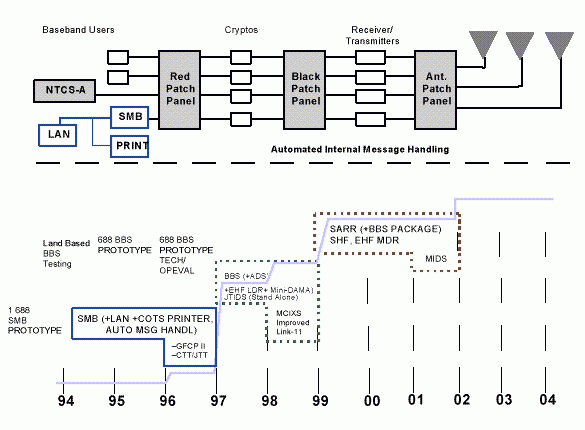
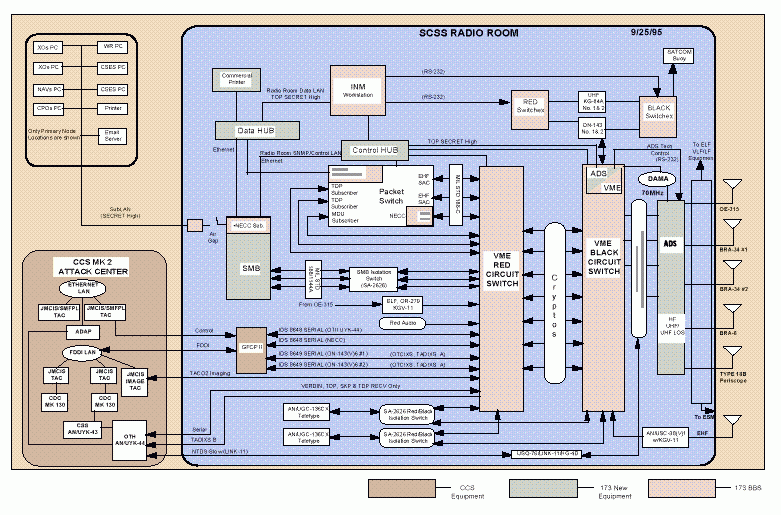


3.2.2 Baseband System Phase (FY97–FY98)
During the BBS Phase, the SSN ECS will begin transitioning to an automated system of OSA
components. A fully automated and integrated ECS will not be achieved in the BBS Phase
because of the retention of significant amounts of legacy equipment. This transition, depicted in
Figure 3-5, will continue into the follow-on SARR Phase. Installations during this phase (BBS,
Mini-DAMA, GFCP II) will support the SCSS ECS architecture and standard interfaces. These
OSA-based equipment will also support data I/O via both legacy interfaces (e.g.,
MIL-STD 188-144) and an Ethernet (IEEE 802.3) data LAN. New equipment will be remotely
controlled via the INM, using SNMP and a radio room control LAN. During this time period,
the SCSS ECS will also integrate the message processing function performed by the SMB into a
Tactical Advanced Computer (TAC)-4 or TAC-5. Figure 3-6 depicts the FY98 SCSS
Architecture, which uses both modern, OSA-based equipment and legacy radio room equipment.
3.2.2.1 Baseband System Prototype Multi-Level Security Implementation
A major feature of the BBS prototype will be electronic message dissemination. This will be
accomplished over the confidential SNAP III/Automated Technical Information System (ATIS)
LAN using ASSURE software with FORTEZZA Personal Computer Memory Card International
Association (PCMCIA) security cards and Lotus Notes (client-server). ASSURE with
FORTEZZA provides capabilities of user identification and authentication (I&A), network
configuration control, network layer encryption and data storage encryption for Novell NetWare
and Windows O/S. It also provides hardware/software protection for the end-user PC and
central management of user profiles. All encryption is MISSI compliant, using the FORTEZZA
card for I&A and for encryption of data at the SECRET level and below. Lotus Notes v.3
provides access control for multiple operating systems (e.g., Windows, HP-UX, Macintosh,
Solaris, NetWare for the server only). ASSURE with FORTEZZA will provide protection for
the Secret data running over the confidential SNAP/ATIS LAN.
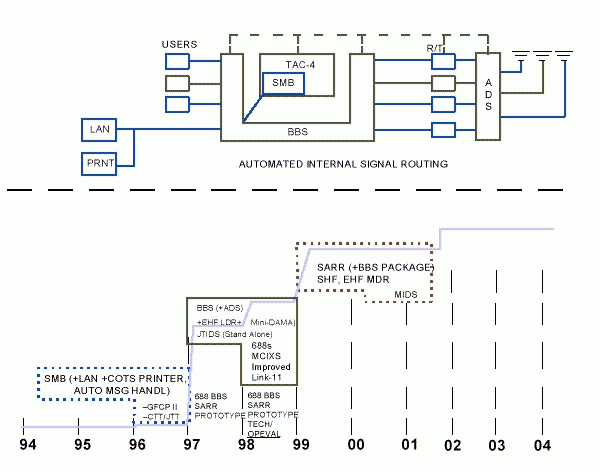
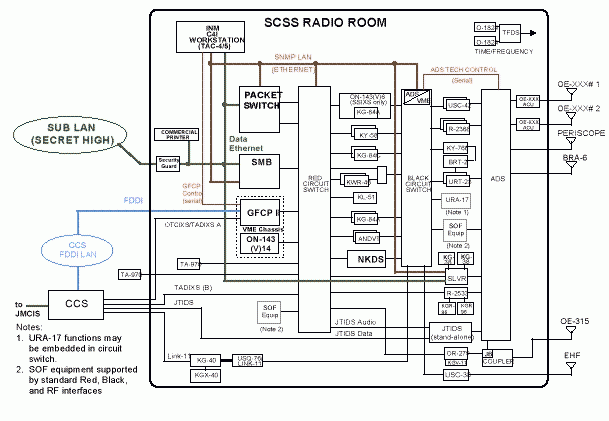 The SMB will interface with the Red BBS to receive and transmit over-the-air message traffic, as
in the current baseline. The SMB parses and profiles the messages, queuing the SECRET and
below messages for operator review and release to the classified message server (running Lotus
Notes and ASSURE). The SMB will transmit messages using SMTP-based e-mail to the Lotus
Notes Server, via the Lotus Notes Gateway. The server will automatically address e-mail to the
appropriate recipient(s), encrypting with FORTEZZA for FORTEZZA-capable LAN
workstations. Figure 3-7 illustrates the recommended configuration of ASSURE and Notes with
the SCSS and the SNAP-III/ATIS LAN, with the exception that, for the BBS Prototype, Notes
will not be FORTEZZA-capable.
The Multi-Level Security (MLS) implementation for the BBS Prototype will be functionally
identical to the FY96 Production implementation, discussed in Section 3.3. The differences are:
Lotus Notes v.3 will be used instead of the Notes Data Management System (DMS) v.4
(encryption provided by ASSURE with FORTEZZA rather than Notes with FORTEZZA
(DMS v.4)) and the MLS device will be a simple A/B type switch instead of a MISSI Guard with
filters.
The SMB will interface with the Red BBS to receive and transmit over-the-air message traffic, as
in the current baseline. The SMB parses and profiles the messages, queuing the SECRET and
below messages for operator review and release to the classified message server (running Lotus
Notes and ASSURE). The SMB will transmit messages using SMTP-based e-mail to the Lotus
Notes Server, via the Lotus Notes Gateway. The server will automatically address e-mail to the
appropriate recipient(s), encrypting with FORTEZZA for FORTEZZA-capable LAN
workstations. Figure 3-7 illustrates the recommended configuration of ASSURE and Notes with
the SCSS and the SNAP-III/ATIS LAN, with the exception that, for the BBS Prototype, Notes
will not be FORTEZZA-capable.
The Multi-Level Security (MLS) implementation for the BBS Prototype will be functionally
identical to the FY96 Production implementation, discussed in Section 3.3. The differences are:
Lotus Notes v.3 will be used instead of the Notes Data Management System (DMS) v.4
(encryption provided by ASSURE with FORTEZZA rather than Notes with FORTEZZA
(DMS v.4)) and the MLS device will be a simple A/B type switch instead of a MISSI Guard with
filters.
3.2.3 Submarine Automated Radio Room (FY99–FY04+)
During the SARR Phase, depicted in Figure 3-8, the SCSS ECS will be increasingly automated
and integrated. The hybrid (part OSA, part legacy) SCSS ECS will be fielded by FY00.
Additional efforts include further SCSS prototyping on-board an SSN 688 class submarine. The
goal of this prototype effort will be to more fully automate and miniaturize the SCSS ECS, in
preparation for the 9-rack NSSN-variant of the SCSS ECS (the NSSN ECS). The NSSN ECS is
required in early FY01 to support new construction platform integration testing. SARR phase
efforts will apply to all submarine classes, including TRIDENTs. TRIDENT IRR is currently
planned to remain frozen until FY01, with the exception of TRIDENT EHF installations and the
requirement for multiple HIDAR receivers to be installed prior to FY00. The planned Initial
Operational Capability (IOC) for the TRIDENT ECS is FY01; Full Operational Capability (FOC)
is scheduled for FY06. Potential exists for the conversion of non-D-5 TRIDENT submarines to
SSGN or dry deck shelter/advanced swimmer delivery system platforms. If converted, SSN
variant SCSS ECS upgrades will be required.
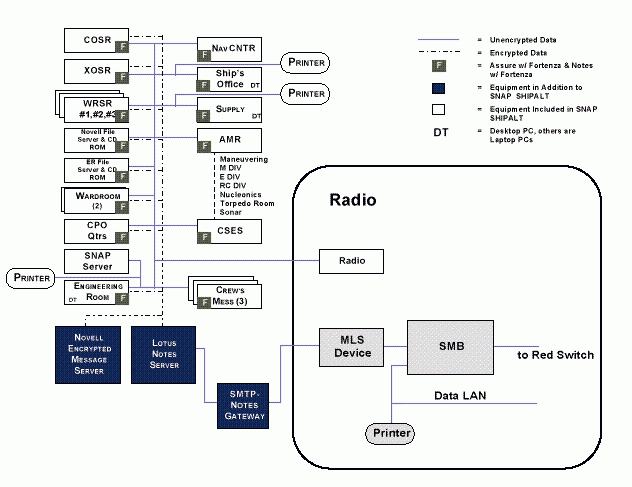
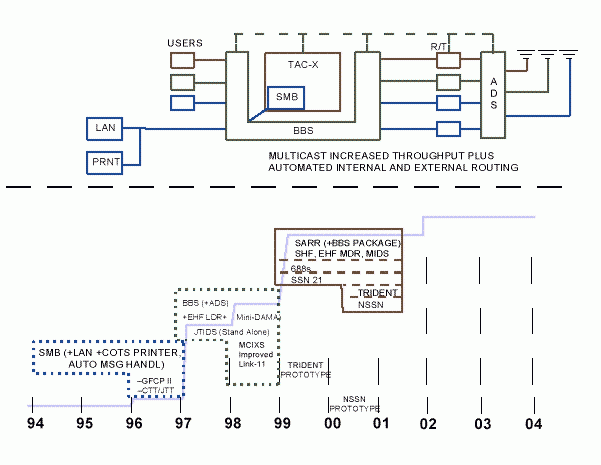
3.2.4 Submarine Communications Support System Goal Architecture
In the SCSS goal signal environment, the analog output of all RF sensors will be converted to a
digital format before any signal processing steps are encountered in the signal flow path.
These
digitally formatted signals will be packetized and then transported over a diffuse Asynchronous
Transfer Mode (ATM)-based backplane. Signal processing will then be performed by ‘virtual
components’ formed by ‘virtual connection’ of cards/electronic units housed in common
VME/VMEbus Extension for Instrumentation (VXI) racks. This results in a localized
fibersphere whereby an interface with a sensor can be established at any port of the diffuse mesh
constituting the fibersphere. The high-bandwidth generic information-transport infrastructure
will support all information interchange and provide a means to incorporate high-bandwidth
satellite links to furnish a seamless bridge between the on-board infrastructure and a global grid,
i.e., all on-board systems and data sources can have worldwide connectivity. Additionally, the
space and weight requirements for the communications system should decrease dramatically.
3.3 INFORMATION SECURITY CONSIDERATIONS
3.3.1 Information Security Requirements
The current trend in system security certification and accreditation is away from evaluation of
stand alone systems by National Security Agency (NSA) and towards accreditation of systems in
their use environment. Therefore, the system shall be designed and developed such that it will
be certifiable and accreditable by the Designated Approval Authority (DAA at the lowest
possible cost.
System security features will include:
- I&A,
- Access Control,
- Audit,
- System Integrity,
- Data Integrity,
- Assurance,
- Classification Bannering,
- TEMPEST,
- Compatibility with DMS, JMCIS, SNAP-III and other installed systems, and
- Security Labeling.
3.3.2 Future Goal
The ultimate future goal for SCSS is to provide an automated ECS which will be: paperless and
at the discretion of the ship, unmanned and remotely operated from the ship’s control room.
Automation will be accomplished by computers performing most, if not all, of the processing
and internal electronic routing of messages. The paperless ECS will make hand routing of
messages via message clipboards obsolete by making maximum use of the electronic message
routing afforded by automation. The remote operation feature of the ECS ideally allows the use
of personnel from computer-based technical ratings as remote system operators thus reducing
shipboard manning requirements. The key to meeting this goal, however, lies in satisfying
fundamental security requirements such as secure transmission or encryption methods. System
operation without operator intervention implies the use of Multi-level Security (MLS) trusted
operating systems or processes.
3.3.3 Implementation
The SCSS will evolve from System High Mode of operations with Periods Processing to an
MLS Mode of operations. This will be accomplished through “evolutionary production,”
introducing MLS products as they become available. As the system requirements change, the
security architecture will change also.
3.3.3.1 FY96 Submarine Communications Support System
The SMB will interface with the red BBS to receive and transmit over-the-air message traffic, as
in the current baseline. The SMB parses and profiles the messages, queuing the Secret and
below messages for operator review and release to the classified message server (Lotus Notes).
The SMB will transmit messages using DMS X.400 e-mail or SMTP-based e-mail through the
DMS Multifunction Interpreter (MFI), to the Lotus Notes Server via the Lotus Notes Gateway.
The server will automatically address e-mail to the appropriate recipient(s), encrypting with
FORTEZZA for FORTEZZA capable LAN workstations. A MISSI Guard with filters for Navy
Message formats will be used to automatically read the classification of the incoming messages,
ensuring that the SMB, or operator, does not accidentally pass a message classified higher than
Secret.
3.3.3.2 FY98 Submarine Communications Support System
A major feature of the FY98 production will be electronic message dissemination. This will be
accomplished over the Confidential SNAP III/ATIS LAN using ASSURE with FORTEZZA and
Lotus Notes with FORTEZZA (client-server). ASSURE with FORTEZZA provides capabilities
of user I&A, network configuration control, network layer encryption and data storage
encryption for Novell NetWare and Windows O/S, and hardware/software protection for the
end-user PC. All encryption is MISSI compliant, using the FORTEZZA card for I&A and for
encryption of data at the SECRET level and below. FORTEZZA is currently authorized for
classification levels up to Secret, with future versions capable of TS or TS/SCI. Lotus Notes
DMS v.4 provides capabilities of user I&A, access control, network layer encryption and
file/field/document encryption for multiple operating systems (e.g., Windows, HP-UX,
Macintosh, Solaris, NetWare for the server only). Encryption is MISSI compliant, using the
FORTEZZA card for I&A and for encryption of data at the level of SECRET and below. All e-mail
functions are DMS compliant. A combination of the security mechanisms of ASSURE and
Lotus Notes provides protection for the SECRET data running over the Confidential
SNAP/ATIS LAN.
3.3.3.3 Goal Submarine Communications Support System Multi-Level Security
The Goal SCSS will implement MLS through the use of several MLS products in order to
support the transition to complete automation. In addition, it will use Embedded
(programmable) INFOSEC Products (EIP/PEIP) to replace the existing crypto systems with
much smaller crypto devices. Figure 3-9 shows a functional block diagram of the future SARR.
The Trusted Labeler will assign classification labels to all incoming messages and pass the data
to an Automated Message Handling System (AMHS). The AMHS function, combined with
Type 1 encryption hardware/software, provides protection for classified data running over the
ship’s LAN (SubLAN). There may need to be multiple copies of the Labeler or AMHS, running
at single or multiple classification levels, depending on the level of trusted software available.
Some of these functions may be incorporated into DMS components or may be separate, but all
must be DMS compliant. To automate the process, the Labeler and AMHS functions must be
trusted.
3.4 FIXED SUBMARINE BROADCAST SYSTEM
3.4.1 Fixed Submarine Broadcast System
Efforts and analysis are being performed to automate and consolidate the submarine shore
communications infrastructure, particularly the VLF and LF shore systems in an effort to
improve operational efficiency while reducing operating costs. Initiatives in progress or being
analyzed are summarized below. For a more detailed explanation, refer to Appendix B.
For the VLF/LF shore broadcast systems, programs are in place to maintain existing systems and
to replace vacuum tube type amplifiers with solid state technology. Implementation of more
cost-effective connectivity to the Broadcast Keying Stations (BKSs) from the Broadcast Control
Authorities (BCAs) is being addressed. The Office of Chief of Naval Operations (OPNAV) has
approved a plan to consolidate the 11 worldwide BKSs to four BKSs, two for the Atlantic fleet
and two for the Pacific fleet. Cost saving initiatives associated with remote transmitter operation
and power management of the VLF and LF shore transmitting facilities are being tested and are
planned to be fielded. Other VLF/LF program initiatives being evaluated include use of Range
Extension, Dynamic Channelization, and Split Array operation of the VLF sites.
Lastly, SPAWAR PMW 173 has been directed to develop a plan to modernize and maintain the
submarine BCAs, based on TYCOM requirements submitted to N87. N87 will sponsor these
needed upgrades. The purpose of this plan is to document how the communications equipment
at the BCAs will be modernized to remain fully interoperable with SCSS, JMCIS, and GCCS as
these systems and architectures evolve. This plan and the resulting efforts will also ensure that
BCA equipment is fully supported logistically and all new equipment is integrated into the
existing BCA suite.

3.4.2 Global Broadcast Service
The MNS for a GBS has been given validation approval by the Joint Staff. This MNS outlines
the need for asymmetric flow of information to deployed units to cover products tailored to their
operating areas. This data includes local weather forecasts, environmental updates, intelligence
data, imagery, high-speed computer updates, battle damage assessments, news updates, and
TOMAHAWK Mission Data Updates and composites.
This system is envisioned to be a militarized version of the commercial direct broadcast system
(currently providing up to 500 channels via an 18-inch dish antenna) which will provide a global
dissemination of large volumes of information in a timely fashion by providing standardized
products to a large group of users and on-demand products to specific groups of users. GBS has
the capability of providing very high data rates (up to 20 Mbps) into small receive antennas. A
TOMAHAWK Mission Data Update (MDU) can be received in approximately 2 seconds. The
GBS system is envisioned to use COTS receivers.
The concept is depicted in Figure 3-10. The Joint Staff is the lead in developing the GBS system
concept and consolidating GBS requirements. As the Joint Staff moves forward with this
system, NUWC will begin investigating antenna technology solutions compatible with the GBS
system.
The SCMP will be the one document promulgating these requirements and stating the
acquisition strategy.

3.6 Submarine Communications Support System Training and Logistics Support
Concepts
3.6.1 Transition to Onboard Training
The training goal for the SCSS ECS is to maximize the use of Computer-Based Training (CBT),
Interactive Electronic Technical Manuals (IETMs) and other performance support tools to reduce
duplicative based training requirements and provide single media training supporting both
maintenance and operational training requirements. The move towards total On-Board Training
(OBT) will be an evolutionary process. The process will progress from a combination of OBT,
CBT, IETMs, and formal school house training toward the goal of total OBT, where appropriate.
The CBT will be unique because the supporting IETM will be linked to the training program
software and vice versa. The equipment level CBT modules will become a part of the larger
SCSS System Level Training System. The SCSS System Level Training System and equipment
level CBT, along with the IETMs will be available via the SNAP III/ATIS LAN. The CBT and
IETMs will comply with the Navy’s portability standards and therefore, can be hosted on a
variety of platforms such as laptops, operational workstations, and PCs. All SCSS training
products will be coordinated through COMSUBGRU TWO, New London.
3.6.2 Logistics Support
In all phases of the transition to the goal architecture, the existing Navy supply system will be
used to support the supply needs of the SCSS ECS. As this transition proceeds, however, the
support methodology will change from one based on in-depth stocking of repair parts and
government depot repair to logistic support based on higher level (e.g., VMEbus board) lowest
field replaceable units (LFRUs). Repair parts will be covered by manufacturer warranties and
commercial market place driven upgrade paths with approximately 2 year life cycles. In many
cases, one or more VMEbus boards may be replaced by a single upgraded processor board
before the boards being replaced approach their Mean Time Between Operational Mission
Failures (MTBOMF). As OSA-based systems such as Mini-DAMA, GFCP II, and SLVR are
installed in the SCSS ECS, the number of on-board repair parts will reflect the significant
number of VMEbus boards common to all these systems. The Naval Inventory Control Point
(NAVICP), Mechanicsburg, PA will become the Supply Support Logistics Element Manager
(SSLEM) and will establish Basic Ordering Agreements (BOAs) with the Original Equipment
Manufacturers (OEMs) to obtain new parts.




















